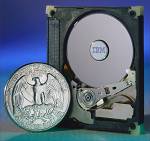 Microdrive capacities to get a big boost!
Microdrive capacities to get a big boost!
By
Mike Tomkins
(Monday, May 21, 2001 - 12:59 EDT)
IBM increases hard drive densities with a sprinkling of 'pixie dust'...
A news item on c|net's News.Com website predicts significant increases in hard drive capacities from IBM... c|net's Richard Shim and John G. Spooner report that the new technology, which adds a three atom thick layer of ruthenium to the disk platters inside hard drives, is called antiferromagnetically coupled (AFC) media.
Referred to informally by IBM as 'pixie dust', the techology is already in use in the latest generation of TravelStar hard drives for notebook computers. Whilst current hard drive technology has a maximum data density of about 20 gigabits per square inch, the new TravelStar AFC drives have a data density of 25.7 gigabits per square inch, and IBM predicts that it will be able to raise this to 100 gigabits per square inch by 2003. IBM expects by this time to extend storage capacities for desktop drives to 400GB and notebook drives to 200GB, whilst the tiny CompactFlash Type-II Microdrive should be able to reach a whopping 6GB. IBM's own press release on the announcement notes that a 6GB MicroDrive would be able to store 13 hours of MPEG-4 compressed video.
According to c|net's item, storage research company Disk/Trend's President, Jim Porter, predicts that the new technology should not significantly increase the cost of hard disk drives because the capacity increase comes without the cost of extra heads and platters... Whilst the full impact of AFC technology may still be a couple of years away, assuming the same immediate density increases that have been shown in IBM's TravelStar drives we can look forward to Microdrives in the region of 1.3GB in the not too distant future...
IBM intends to introduce the technology across its entire hard drive line, and Porter predicts that competitors such as Seagate and Fujitsu are likely to follow suit soon. The company tripled the capacity of its MicrodDrive line, which initially shipped with a maximum capacity of 340MB, to 1GB last June...
Source:
c|net News.Com
Thanks to
LetsGoDigital.nl
for this item!
|
Original Source Press Release:
| IBM "pixie dust" breakthrough quadruples disk drive density IBM is using a few atoms of "pixie dust" to push back the data storage industry's most formidable barrier.
The company is first to mass-produce computer hard disk drives using a revolutionary new type of magnetic coating that is expected to quadruple the data density of current hard disk drive products -- a level previously thought impossible, but crucial to continue expanding the information-hungry Internet economy.
For consumers, increased data density will hasten the transition in home entertainment from passive analog technologies to interactive digital formats.
The key to IBM's new data storage breakthrough is a three-atom-thick layer of the element ruthenium, a precious metal similar to platinum, sandwiched between two magnetic layers. That only a few atoms could have such a dramatic impact caused some IBM scientists to refer to the ruthenium layer informally as "pixie dust."
Known technically as "antiferromagnetically-coupled (AFC) media," the new multilayer coating is expected to permit hard-disk drives to store 100 billion bits (gigabits) of data per square inch of disk area by 2003. AFC media is being shipped in IBM's Travelstar notebook hard disk drive products with data densities up to 25.7 gigabits per square inch.
The increasing data densities enabled by AFC media are expected to simplify processes for storing consumers' rapidly growing volumes of digital data (music, photographs, presentations and video); accelerate an industry trend toward smaller disk-drive form factors that consume less energy; and stimulate the creation of new and more capable digital-media and data-intensive applications.
IBM plans to implement AFC media across all its disk drive product lines.
With AFC media, 100-gigabit data density could allow the following capacities within two years: - Desktop drives -- 400 gigabytes (GB) or the information in 400,000 books.
- Notebook drives -- 200 GB, equivalent to 42 DVDs or more than 300 CDs.
- IBM's one-inch Microdrive -- 6 GB or 13 hours of MPEG-4 compressed digital video (about eight complete movies) for handheld devices.
|
Powered by Coranto
|